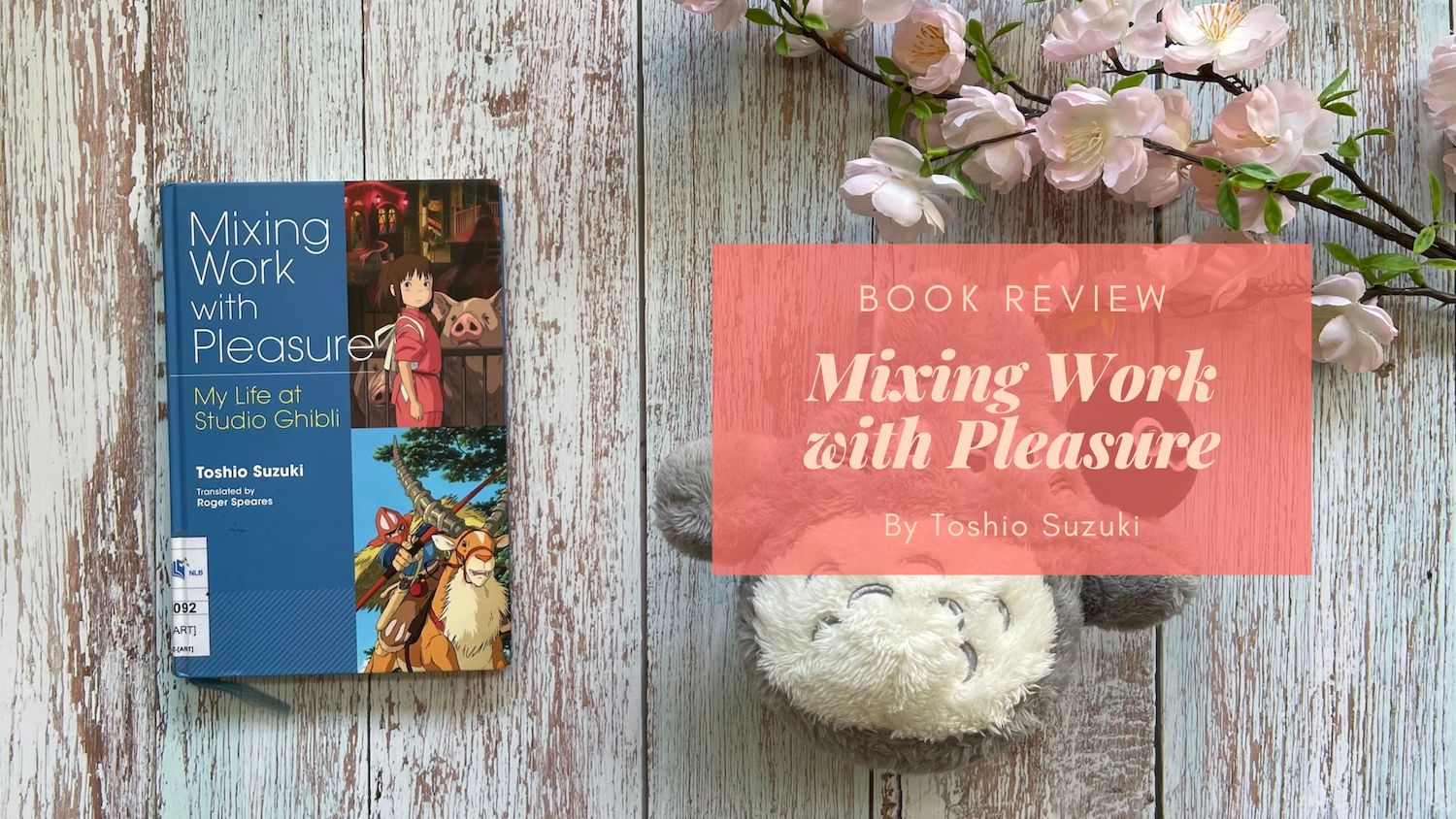It has been some time since I talked about Studio Ghibli, so it’s time to remind everyone that Studio Ghibli makes amazing films by talking about Mixing Work with Pleasure, Toshio Suzuki’s account of his time spent at Studio Ghibli as a producer and company president. If you want to see some of his calligraphy, I have pictures in my post on the Suzuki Toshio & Ghibli Exhibition at Huis ten Bosch!
Right from the start of the book, Suzuki talks about a habit of his: forgetting the past (something that he apparently shares with Hayao Miyazaki, aka ‘Miya-san’). He’s a man who lives in the present, which is why writing this book was not something that came naturally to him; in fact, he ends the book by mentioned that he checked with a colleague who took notes and the timeline showed some discrepancies – a fitting ending, in my opinion. However, I’m glad he allowed himself to be persuaded and was interviewed for this book because it has so much interesting information.
While I knew that Studio Ghibli was for Hayao Miyazaki and Isao Takahata, I didn’t realise until reading this that the studio was set up for Miyazaki and Takahata because they couldn’t find many places to product their works! It explains why the studio had such a strong focus on these two directors and why it never seemed to want to aggressively make movies.
Getting to know the behind-the-scenes stories of the movies was, of course, the highlight for me. From Miyazaki’s desire to live in the moment and how he bases his drawings on what leaves an impression on him to Takahata’s desire to be accurate in what he draws – to the point that in order to draw a scene picking safflowers, Takahata read all the books available about the topic, visited three farmhouses, and even wanted to visit a master of the craft (he had to be persuaded to just send his notes to check for accuracy) – I was left impressed by the two directors. They are definitely geniuses in the world of animation!
By the way, another point about Takahata’s insistence of accuracy which I couldn’t fit into the previous paragraph: if you’ve watched Grave of the Fireflies (and if you haven’t, you should because I cried the entire last half of the film), you would have seen an air raid scene. Takahata was so concerned about the direction the B-29s were coming from and how it would play out from where the protagonist was standing that he researched contemporary records, resulting in a historically accurate scene that not many people may notice.
To be fair, let me talk about Miyazaki for a bit. I mentioned Miyazaki’s desire to draw from memory, and that played out after a trip to the Aran islands. Miyazaki drank in the look of an inn and it stayed with him so much that parts of it became one of the houses in Kiki’s delivery service! He’s also the type of person that will watch a movie to see the armour the people are wearing but not follow the story, and he’s the type of person that will interrupt you at work to ask what you are watching and reading to get inspired.
And for the people who know about the theory that the bathhouse in Spirited Away is a prostitution metaphor, I saw an interesting anecdote. In the section on being inspired by casual conversations, Suzuki mentions that Miyazaki took inspiration from a story about cabaret clubs. But it’s not about the sex trade, it’s because of a theory that many of the women who work there are shy and to make a living, have to learn conversational skills. Similarly, the men who go there have to learn to talk to the hostesses. He took this idea of having to learn communication skills to make a living and gave it to Chihiro, who had to communicate with those around her (by contrast, No Face did not and ended up running wild). So yes, Spirited Away was inspired by a story about cabarets but it’s not about the sex trade.
There are many pictures of postcards and other drawings in between the chapters of this book. While you don’t need to know Japanese to read this English translation, and most of the pictures are described in detail, the Japanese on the pictures made me want to read the original Japanese version of this book! I’d probably take a much longer time, but I imagine it would be a rewarding experience as well.
It’s actually pretty hard for me to figure out what I want to say about this book. I had a lot of thoughts while reading it, but I didn’t actually take notes and now that I’m writing this, I find that I’m not sure how to express what I do remember, and I’ve forgotten everything else! I suppose I picked up a bit of Suzuki and Miyazaki’s habits, but without their ability to work as brilliantly [laughs].

As a huge Ghibli movies fan, this sounds absolutely awesome. I’d love to get more behind-the-scenes info on these beautiful animated stories. Thanks for sharing this, Eustacia! 🙂
If you love the Ghibli movies, you definitely have to read this! Suzuki-san shares a LOT about what went on behind the scenes!
Thanks for this! Discovered this blog searching for info about this book. There was an article that described how Miyazaki decided to make Spirited Away for 10 year old girls after reading shojò mangas that only had love and crushes 😍
Oooh, somehow I’ve not heard that. I’ll have to look it up some more!